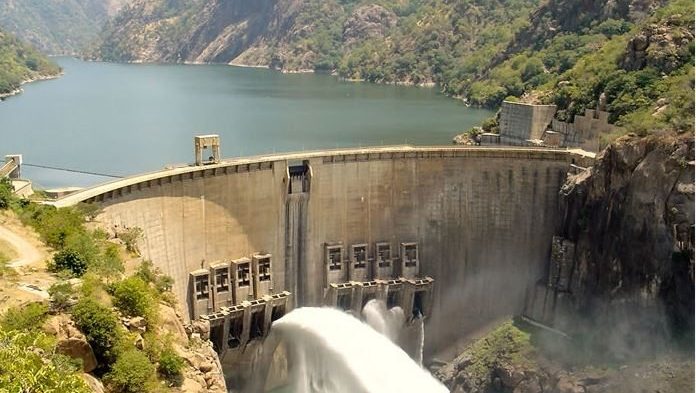
Cameroon dam opening: Evacuate to prevent deaths, FG, states warn flood-prone communities
The release of huge volumes of water from the Lagdo Dam in Cameroon has made states along the path of River Benue in Nigeria brace up for possible flood disasters in their various domains.
In order to prevent deaths and other impending disasters associated with floods, states that are likely to be affected have asked residents of the flood-prone areas to vacate such communities.
Speaking by the National Emergency Management Agency officials, no fewer than 11 states including Adamawa, Taraba, Benue, Nasarawa, Kogi, Anambra, Edo, Delta, Bayelsa, Rivers and Cross River are likely to feel the negative impacts of the opening of the dam.
The states on Sunday advised such residents to leave the areas to avoid impacts on human lives and valuable assets.
It was gathered on Sunday that Cameroon informed the Federal Government that it would soon open its Lagdo Dam.
The Director of the African Affairs, Federal Ministry of Foreign Affairs, Umar Salisu, said in a letter dated August 21, 2023, that the ministry received a note from the High Commission of Cameroon as regards the opening of the dam.
The letter, which was addressed to the National Emergency Management Agency, read in part, “I have the honour to inform that the ministry is in receipt of a Note Verbale from the High Commission of the Republic of Cameroon informing that Cameroonian officials have resolved to open the flood gates of the Lagdo Dam on the Benue River in days ahead due to the heavy rainfall around the dam catchment area in Northern Cameroon.”
The letter stated that it was pertinent to note that when the release of water became necessary, the authorities of the Lagdo Dam would be releasing only a modulated variable small amount of water at a time in order to mitigate and avoid damage that the released water might cause along the River Benue basin in both Cameroon and in Nigeria.
“In view of the above, it would be appreciated if the esteemed agency takes all the necessary proactive steps and actions that will mitigate the damage as well as sensitise the populace living in such areas to vigilance and all necessary precautions.”
Lagdo Dam, located 50 kilometers south of the city of Garoua on the Benue River, often releases huge volumes of water when overflowing and this leads to flooding in various states downstream of Nigeria.
Based on this development, some states to be affected by the opening of the dam confirmed on Sunday that they would demolish structures on waterways, while others earmarked some schools to serve as camps for internally displaced persons.
Officials of the National Emergency Management Agency and the Nigeria Hydrological Services Agency said 11 states were along the path of River Benue and are going to be affected by the opening of Lagdo Dam.
Although they noted that there was no cause for alarm, they named the states to include Adamawa, Taraba, Benue, Nasarawa, Kogi, Anambra, Edo, Delta, Bayelsa, Rivers and Cross River.
State governments informed
The Head of Media and Public Relations, NEMA, Ezikiel Manzo, said the agency had informed the state governors, adding that the states had been advised on what to do to mitigate the impact of possible floods.
“We have introduced this into all our awareness programmes and in addition to that, NEMA has written to all the governors to alert them. We have also mentioned the things that they need to do in order to mitigate the impact of the flood.
“So what this means is that with this information concerning the excess water being released from the dam, it means that all the state governments along the River Benue axis, the time has come for them to match action with the information that has been given to them in anticipation of this flood.
“And some of the things they need to do is for them to immediately monitor the people and communities along the flood pathway and begin to move them away from danger.
“They (Lagdo Dam) are just beginning the release of the water, we don’t know, but if the rain increases and the release of the water continues, it means the people will need to move quickly out of the floodplain.”
Manzo, however, stated that ‘if after this initial release we do not have much rain again, then it means they are going to stop. I’m saying this because we don’t want to send people panicking that the release means that they should run away completely from the river bank.
“But what we are saying is that the time has come for the people to be conscious of the risk that is lying beside them in terms of the likelihood that the river will overflow its bank.”
Asked to name the states that are likely to be affected, the NEMA official said, “They include Adamawa, Taraba, Benue, Nasarawa, Kogi. Then from Kogi, we have states like Anambra, Edo, Delta, and Bayelsa.”
‘Dam opened August 14’
The Director-General of the Nigeria Hydrological Services Agency, Clement Nze, also confirmed the letter but noted that the dam had been releasing water before the letter was sent to Nigeria by Cameroon.
“Yes, that letter was signed on August 21, 2023, by the African Affairs officer at the foreign affairs ministry here in Nigeria. The Adamawa State Government issued a press release recently, which my permanent secretary drew my attention to last week, on Tuesday precisely.
“I got in contact with the manager of the dam last Wednesday and he confirmed that they opened the dam on August 14, 2023, at 10.10 am. He said they had been spilling water at the rate of 200 cubic metres per second, which is about 20 million cubic meters per day.
“So the letter to the foreign affairs ministry is just to officially state it, but they have been releasing water before issuing that letter. They also confirmed to me on Friday that because of the huge volume they have released downstream, they decided to reduce it to 50 cubic meters per second, which is about five million cubic meters per day.”
Meanwhile, Nze explained that the flow of the water from the dam had nothing to do with Niger, Kwara and Kebbi states, “but after reaching River Niger, it will start moving down to Edo, Delta, Anambra and then to Rivers, Bayelsa, before it enters the Atlantic Ocean.”
He noted that the flow could get to part of Cross River, but stated that there was no cause for alarm currently, though it was vital for the governors of the identified states to make all the necessary preparations.
Commenting on the development, the acting Executive Secretary of the Benue State Emergency Management Agency, James Iorpuu, said some of the activities of residents on the river banks and along the water channels, which could contribute to blocking the drains, were being removed.
He said, “We have created designated locations where we will relocate those living around the banks of River Benue and people occupying flood-prone areas across the 22 Local Government Areas that will be affected by flooding.
“We have also embarked on a sensitisation and awareness campaign on the need for people to vacate flood-prone areas. We have also met with traditional rulers, civil societies and other stakeholders on the need to advise their subjects to leave areas that are vulnerable to flood.
“We are calling on residents living along the river banks to move to higher grounds in Makurdi town for safety. We have designated public schools across the 22 Local Government Areas prone to flood as camps for victims of the flood.”
Iorpuu identified some areas within the capital city of Makurdi prone to flooding including Achusa, Idye, Wurukum Market, Genabe, Industrial Layout, Demekpe, Wadata Market, Rice Mill, Inongun, Agbohough, Judges Quarters and Gyado Villa.
In Nasarawa, the state government announced its decision to demolish all structures built on waterways across the 13 local government Areas of the state in a bid to tackle issues relating to flooding.
The Commissioner for Environment and Natural Resources, Kwanta Yakubu, stated this while briefing journalists immediately after monitoring the monthly sanitation exercise in Lafia on Saturday.
Yakubu, who was represented by the Chief Environment Officer and Chief Prosecutor of the ministry, Abubakar Mohammed, said the action was a result of the recent prediction by the Nigerian Meteorological Agency that 25 states of the federation including Nasarawa, would experience flooding.
He explained that the state government had already directed residents who were residing in flood-prone areas to relocate to safer areas in order to protect themselves from the floods.
“We have been moving from one local government Area to another to sensitise communities in order to minimise the effect of floods in the state,” he added.
In Taraba, the state government said it had alerted six local government areas and issued warnings to residents living in flood-prone areas to relocate to safer areas.
The Commissioner for Information and Re-orientation, Zainab Jalingo, said communities around Karim-Lamido, Lau, Ardo-Kola, Gassol, Wukari, to Ibi local government areas would be affected.
“I want to alert the general populace, and particularly those residing within the environs of the River Benue valley, of a matter of utmost importance.
“Our intention is to earnestly advise residents to consider relocating to secure areas as a prudent measure against the imminent ri





